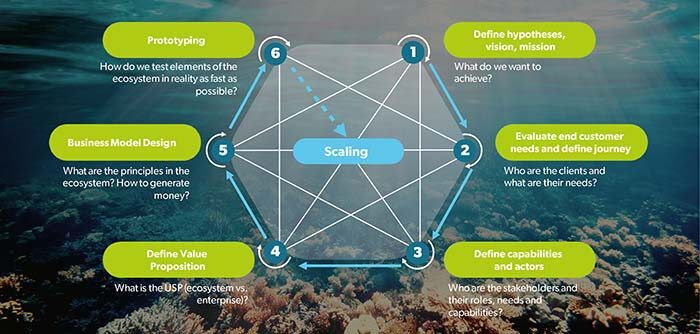
The idea that collaboration with other companies brings benefits has been around for a very long time. Due to the more networked economy, technological change and changing end customer needs, this rather rigid and inflexible idea of one-dimensional cooperation has evolved towards ecosystems. Ecosystems create a cohesive value proposition that is greater than the sum of the individual value propositions of the participants. By breaking down product and service boundaries, players from outside the industry as well as established companies have the opportunity to enter new markets. Ecosystems are already widespread today. For example, most companies in the S&P 500 Index are building ecosystems and this will continue to accentuate.
According to studies, around 30 percent of all revenues in the economy worldwide will result from ecosystems by 2025. That guarantee companies supposedly long-term growth opportunities in terms of new services and customers.

Due to the lack of a uniform definition of ecosystems, there are different approaches to how they function. However, two basic roles can often be observed within an ecosystem that actors can assume: Orchestrator and Contributor/Participant.
Orchestrators often see themselves as initiators and lead the ecosystem. They want to incentivize companies with different competencies - independent of the industry - to join the ecosystem. The company acts as an intermediary, orchestrates the collaboration of companies and often brings knowledge around infrastructures and platforms.
Contributor or Participant are actors who actively participate in the ecosystem. They aim to improve their offering through active collaboration with the Orchestrator and other partners. In doing so, they extend and support their own and the ecosystem's value proposition. There are also suppliers who operate in the background and provide technical infrastructure, for example.
Assuming a role may seem simple in theory, but in practice it is complex and should therefore not be seen as a matter of course but should be strategically anchored. The upstream consideration for this is whether an ecosystem is even the right approach to solving the problem. Once this is clear, there are also issues to address regarding the governance of the ecosystem, such as legal aspects, marketing, profit distribution, or infrastructure.

The ecosystem navigator serves as a framework and is intended to provide a structure for the strategy development process. The focus is primarily on the strategic aspects of the ecosystem, such as the value proposition or the business model, and less on operational implementation and scaling. The Navigator is applicable across industries, as existing industry boundaries are usually broken down in an ecosystem. To implement this new form of service delivery in an ecosystem, co-creation between partners and the end customer must take place. Our experience shows that this approach causes difficulties for companies. So far, the customer experience has mostly been limited to the purchase of a single product or the use of an isolated service, but in the future, offerings will continue to merge, and industry boundaries will be broken down.
With the Ecosystem Navigator, a prototype of an ecosystem is built within six phases in an iterative process. This can be done along the lines of an MVP (Minimal Viable Product), also called MVE (Minimal Viable Ecosystem). Various elements such as end customer needs, the company's own role as well as the role of other participants and the business model design are covered and coordinated. The Navigator provides companies with a tool that promotes understanding of ecosystems and can serve as a starting point for their own successful ecosystem or its participation.
Due to the lack of uniform definitions for terms such as ecosystem, orchestrator, or participant, a uniform understanding is critical for success. For example, platform business is not synonymous with ecosystems. However, in our experience, this is so ingrained in many minds and could lead to different results as we move through the ecosystem navigator. The benefits of an ecosystem are great: companies can network across industry boundaries and tap into new revenue streams with innovative touchpoints.
In a half-day workshop, fundamental points such as the creation of a baseline, the definition of the framework conditions (e.g., through a corporate strategy), the formulation of initial rough hypotheses, and the customer journey to be addressed can be successfully worked out. In this way, the initially overwhelming and elusive topic of ecosystems can be concretized and made tangible in a manageable format that is understandable for all participants.
First step: Kick-off of the topic "Ecosystems" - Initialization & Baseline setting in the context of a workshop:
- Identification of internal stakeholders
- Create common understanding among all stakeholders
- Setting the framework
- Planning first steps with the help of the Ecosystem Navigator
An in-depth look at the topic with a focus on the insurance industry as well as the ecosystem navigator can be found in the three-part article series.
Part 1: Introduction to the topic of ecosystems
Part 2: Ecosystem Drivers and Ecosystems in the Swiss Insurance Market
Part 3: Ecosystem Navigator
